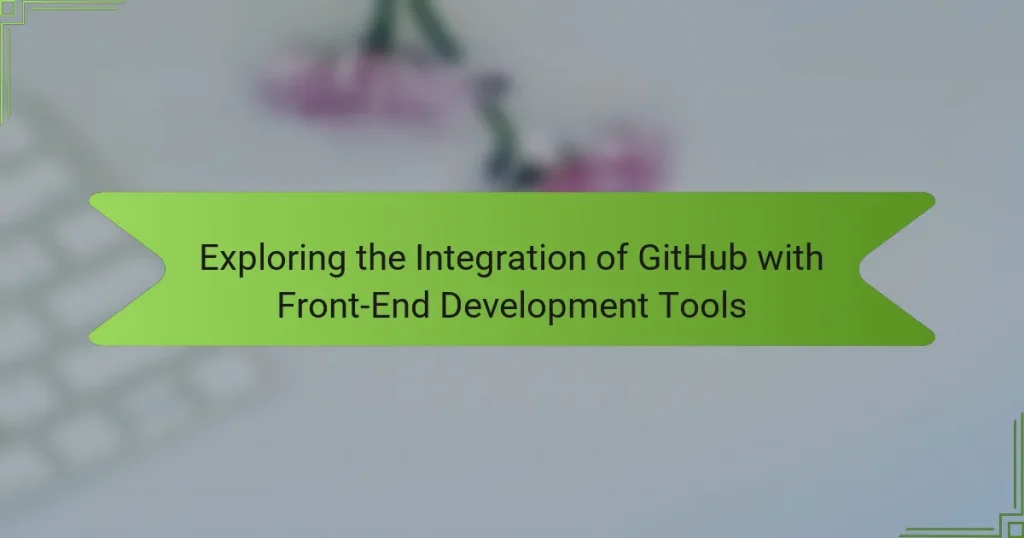The integration of GitHub with front-end development tools enhances collaboration and version control for developers. Key tools such as React, Vue, and Angular can connect directly to GitHub repositories, enabling efficient management of code changes. GitHub Actions further streamline workflows by automating testing and deployment processes. Despite the benefits, developers may encounter challenges related to version control conflicts, compatibility between frameworks, and the complexities of setting up continuous integration and deployment pipelines. This article explores these integrations and the associated challenges, providing insights into improving front-end development workflows.

What is the integration of GitHub with front-end development tools?
The integration of GitHub with front-end development tools allows for streamlined collaboration and version control. GitHub provides repositories for code storage and management. Front-end development tools, such as React, Vue, and Angular, can connect directly to these repositories. This integration enables developers to manage code changes efficiently. Additionally, tools like GitHub Actions facilitate continuous integration and deployment. Developers can automate testing and deployment processes through these actions. The integration also enhances team collaboration by allowing multiple contributors to work simultaneously. Overall, GitHub’s features significantly improve the workflow of front-end development projects.
How does this integration enhance the development process?
This integration enhances the development process by streamlining collaboration and version control. GitHub allows multiple developers to work on the same project simultaneously. It tracks changes in code, making it easy to revert to previous versions if needed. The integration with front-end development tools automates deployment processes. This reduces the time developers spend on manual tasks. Additionally, it fosters better communication among team members through pull requests and code reviews. Research shows that teams using GitHub report a 20% increase in productivity due to these collaborative features. Overall, this integration leads to more efficient workflows and higher quality code.
What are the key features of GitHub that support front-end development?
GitHub offers several key features that support front-end development. Version control allows developers to track changes in their codebase effectively. Collaboration tools enable multiple developers to work on projects simultaneously. Pull requests facilitate code review and discussion before merging changes. GitHub Pages allows developers to host static websites directly from their repositories. Integration with CI/CD tools automates testing and deployment processes. The extensive marketplace offers various apps and tools to enhance development workflows. Finally, issue tracking helps manage tasks and bugs efficiently. These features collectively streamline the front-end development process.
How do front-end development tools leverage GitHub’s capabilities?
Front-end development tools leverage GitHub’s capabilities through version control and collaboration features. These tools integrate directly with GitHub repositories. This allows developers to track changes in their code efficiently. They can collaborate in real-time with team members. GitHub’s pull request feature enables code reviews and discussions. Continuous integration tools can automatically deploy code from GitHub. This streamlines the development workflow significantly. Additionally, GitHub Actions allow for automated testing and deployment processes. These integrations enhance productivity and maintain code quality.
Why is GitHub important for front-end developers?
GitHub is important for front-end developers because it provides a platform for version control and collaboration. It allows developers to track changes in their code efficiently. This is essential for managing projects with multiple contributors. GitHub also facilitates code sharing and reuse. Developers can access a vast repository of open-source projects. This enhances learning and encourages community engagement. Additionally, GitHub integrates with various front-end development tools. This integration streamlines workflows and improves productivity. According to GitHub’s 2021 Octoverse report, over 60 million repositories are hosted, highlighting its significance in the developer community.
What role does version control play in front-end development?
Version control is essential in front-end development for managing code changes. It allows multiple developers to collaborate efficiently on projects. Version control systems, like Git, track changes and maintain a history of modifications. This history enables developers to revert to previous versions if issues arise. Additionally, it facilitates branching, allowing developers to work on features independently. Merging branches helps integrate these features seamlessly into the main project. Version control also supports code reviews, enhancing code quality before integration. Overall, it streamlines collaboration and maintains project integrity.
How does collaboration on GitHub benefit front-end teams?
Collaboration on GitHub benefits front-end teams by streamlining code management and enhancing teamwork. GitHub provides version control, allowing multiple developers to work on the same codebase simultaneously. This reduces the risk of conflicts and errors. Teams can easily track changes, revert to previous versions, and maintain a clean project history. GitHub’s pull request feature facilitates code reviews and discussions, improving code quality. Additionally, it integrates with various front-end development tools, enhancing workflow efficiency. According to a 2021 survey by Stack Overflow, 87% of developers use GitHub, indicating its widespread adoption and reliability among teams.

What are the common front-end development tools that integrate with GitHub?
Common front-end development tools that integrate with GitHub include Visual Studio Code, Webpack, and React. Visual Studio Code is a popular code editor that offers GitHub integration for version control. Webpack is a module bundler that can manage dependencies and deploy projects directly to GitHub repositories. React is a JavaScript library for building user interfaces, and it supports GitHub for collaborative development. Other tools include Angular, Vue.js, and Bootstrap, which also provide GitHub integration for version control and collaboration purposes. These tools enhance the development workflow by enabling seamless collaboration and version tracking directly within GitHub.
How do popular frameworks and libraries utilize GitHub?
Popular frameworks and libraries utilize GitHub for version control and collaboration. They host their source code on GitHub, allowing developers to contribute easily. This platform enables tracking changes and managing project versions effectively. Issues and feature requests are managed through GitHub’s issue tracker. Popular frameworks often use pull requests to review code contributions. Continuous integration and deployment are facilitated through GitHub Actions. Documentation and community support are centralized within GitHub repositories. Many frameworks showcase their usage examples and tutorials in their GitHub pages. This integration enhances community engagement and accelerates development processes.
What specific functionalities do these tools gain from GitHub integration?
Tools gain version control capabilities from GitHub integration. This allows for tracking changes in code over time. Users can collaborate on projects without conflict. GitHub provides a platform for code reviews and feedback. Integration enables automated testing and deployment processes. Tools can access GitHub’s extensive repository network. This enhances resource sharing among developers. Overall, GitHub integration streamlines workflow efficiency in front-end development.
How can developers choose the right tools for their projects?
Developers can choose the right tools for their projects by assessing project requirements and team skills. They should evaluate the specific functionalities needed, such as version control or collaboration features. Compatibility with existing systems is crucial. Developers should also consider the learning curve associated with each tool. Community support and documentation quality can significantly influence tool selection. Cost-effectiveness is another important factor. Tools that integrate well with GitHub can enhance workflow efficiency. Research shows that 70% of developers prefer tools that streamline collaboration and reduce setup time.
What are the best practices for using GitHub with front-end development tools?
Use clear commit messages to describe changes in your GitHub repository. This practice enhances collaboration among team members. Regularly push code to the repository to maintain an up-to-date version of your work. This helps prevent data loss and facilitates smoother collaboration. Organize branches effectively by using a branching strategy like Git Flow. This strategy helps manage features and fixes systematically. Review pull requests thoroughly to ensure code quality and consistency. This practice encourages knowledge sharing and improves code integrity. Use GitHub Actions for continuous integration and deployment. This automation streamlines testing and deployment processes. Regularly update documentation in the repository to keep it aligned with the codebase. This aids future developers in understanding the project.
How can developers set up their GitHub repository for optimal use?
Developers can set up their GitHub repository for optimal use by following best practices. First, they should create a clear and descriptive README file. This file should explain the project’s purpose and usage. Next, they should utilize .gitignore files to exclude unnecessary files from version control. This helps in keeping the repository clean. Developers should also organize their code with a logical folder structure. This makes it easier for others to navigate the project.
Additionally, using branches for feature development is essential. This allows for isolated changes without affecting the main codebase. Developers should also commit changes frequently with clear messages. This practice aids in tracking project history effectively. Finally, they should enable issues and pull requests for collaboration and feedback. These practices enhance productivity and maintainability of the repository.
What strategies can improve collaboration through GitHub?
Utilizing GitHub effectively can significantly enhance collaboration among developers. Strategies include using pull requests for code reviews. This allows team members to provide feedback before merging changes. Implementing branching strategies can help manage different features or fixes independently. Regularly updating project documentation ensures everyone is on the same page. Utilizing GitHub Issues for task management improves tracking of bugs and feature requests. Integrating CI/CD tools automates testing and deployment, fostering smoother collaboration. Utilizing project boards in GitHub enhances visibility of project progress. These strategies collectively improve communication and efficiency within development teams.

What challenges might developers face when integrating GitHub with front-end tools?
Developers may face several challenges when integrating GitHub with front-end tools. One major challenge is managing version control effectively. Conflicts can arise when multiple developers work on the same files simultaneously. This can lead to lost changes or the need for extensive conflict resolution. Another challenge is ensuring compatibility between GitHub and various front-end frameworks. Different frameworks may have unique requirements that complicate integration. Additionally, developers might struggle with automating deployment processes. Setting up continuous integration and continuous deployment (CI/CD) pipelines can be complex and time-consuming. Lastly, understanding GitHub’s API and its limitations can pose difficulties. Developers need to familiarize themselves with the documentation and potential constraints.
How can developers troubleshoot common issues?
Developers can troubleshoot common issues by systematically identifying and resolving problems. They should start by replicating the issue to understand its context. Next, they can review error messages for clues about the underlying problem. Checking logs can provide additional insights into what went wrong.
Utilizing debugging tools is essential for examining code behavior during execution. Developers should also consult documentation for guidance on specific tools or libraries. Engaging with community forums can yield solutions from others who faced similar challenges. Finally, version control systems like GitHub allow developers to track changes and revert to stable versions if necessary.
What are the common pitfalls in GitHub integration?
Common pitfalls in GitHub integration include mismanagement of branches and poor commit practices. Mismanagement occurs when developers do not follow a clear branching strategy. This leads to conflicts and confusion during merges. Poor commit practices involve making vague or overly large commits. This makes it difficult to track changes and understand project history. Additionally, inadequate documentation can hinder collaboration among team members. Without clear guidelines, onboarding new contributors becomes challenging. Lastly, ignoring GitHub’s features, such as pull requests and issues, can limit the effectiveness of the integration. Utilizing these features enhances collaboration and project management.
How can developers effectively resolve conflicts in collaborative projects?
Developers can effectively resolve conflicts in collaborative projects by utilizing version control systems like Git. They should regularly pull the latest changes to stay updated. Clear communication among team members is crucial for understanding differing perspectives. Establishing a code review process helps identify and address potential conflicts early. Developers can also employ branching strategies to isolate features or fixes. This allows for independent work without interference. When conflicts arise, utilizing Git’s merge tools can assist in reconciling differences. Documenting resolutions ensures transparency and aids future collaboration. Regular team meetings can facilitate discussion and foster a collaborative environment.
What tips can enhance the use of GitHub in front-end development?
Utilize GitHub branches to manage features separately from the main codebase. This allows for isolated development and easier integration. Implement pull requests for code reviews and collaboration. This enhances code quality and team communication. Use GitHub Actions to automate workflows like testing and deployment. Automation saves time and reduces human error. Leverage GitHub Issues to track bugs and feature requests. This keeps the development process organized. Document your code and project using README files and wikis. Clear documentation aids in team onboarding and project understanding. Regularly sync your local repository with the remote one to avoid merge conflicts. This ensures everyone is working with the latest code.
How can developers stay updated with GitHub features and tools?
Developers can stay updated with GitHub features and tools by following the official GitHub blog and release notes. The GitHub blog provides regular updates on new features, improvements, and best practices. Developers can also subscribe to GitHub’s newsletter for curated content directly in their inbox. Participating in GitHub community forums allows developers to engage with others and learn about user experiences. Additionally, attending GitHub events and webinars offers insights into the latest tools and features. Following GitHub on social media platforms provides real-time updates and announcements. Lastly, exploring GitHub’s documentation ensures developers have access to comprehensive guides on new functionalities.
What resources are available for learning more about GitHub integration?
Official GitHub documentation provides comprehensive guides on integration. GitHub Learning Lab offers interactive courses on using GitHub effectively. Online platforms like Coursera and Udemy feature courses specifically on GitHub integration. YouTube has numerous tutorials demonstrating practical integration techniques. Blogs and forums, such as Stack Overflow, contain community-driven insights and solutions. GitHub’s own community discussions provide real-time assistance and shared experiences. Books on Git and GitHub also cover integration topics in-depth. These resources collectively enhance understanding of GitHub integration in front-end development.
The main entity of this article is the integration of GitHub with front-end development tools. This integration facilitates streamlined collaboration and version control, allowing developers to manage code changes efficiently while utilizing tools like React, Vue, and Angular. Key features of GitHub, such as version control, pull requests, and GitHub Actions, enhance the development process by automating testing and deployment, fostering better communication among team members, and improving overall workflow efficiency. The article also addresses common challenges developers face during integration and provides best practices for optimizing GitHub usage in front-end development projects.


